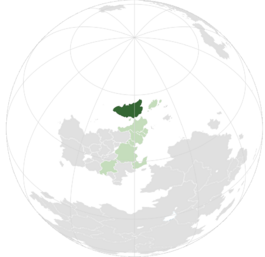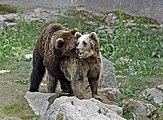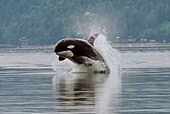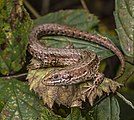Scovern: Difference between revisions
| Line 149: | Line 149: | ||
In 1609, Olav launched the final invasion of Vestelia in the [[Vestelian War]]. Mesconia, now completely dwarfing the Vestelian kingdom, destroyed the Vestelian fleet at the [[Vestelian War|Battle of Mittet]] and sieged Midhamar in only four months. Faced with certain loss, Vestelian king [[Vestelia|Magnar III]] relinquished the Kingdom of Vestelia to Olav and Mesconia in exchange for his life in exile. With the island unified, Olav proclaimed himself King of Scovern in 1611, ending the Scovernois Wars of Unification. | In 1609, Olav launched the final invasion of Vestelia in the [[Vestelian War]]. Mesconia, now completely dwarfing the Vestelian kingdom, destroyed the Vestelian fleet at the [[Vestelian War|Battle of Mittet]] and sieged Midhamar in only four months. Faced with certain loss, Vestelian king [[Vestelia|Magnar III]] relinquished the Kingdom of Vestelia to Olav and Mesconia in exchange for his life in exile. With the island unified, Olav proclaimed himself King of Scovern in 1611, ending the Scovernois Wars of Unification. | ||
=== Early modern period ( | === Early modern period (1611{{ndash}}1846) === | ||
=== Constitutional monarchy (1846{{ndash}}1926) === | === Constitutional monarchy (1846{{ndash}}1926) === | ||
Revision as of 11:23, 11 April 2023
This article is incomplete because it is pending further input from participants, or it is a work-in-progress by one author. Please comment on this article's talk page to share your input, comments and questions. Note: To contribute to this article, you may need to seek help from the author(s) of this page. |
Kingdom of Scovern Kongeriget Skoverne (Mescon) Kongeriket Skogerne (Vestelian) Konungsríkið Skóþjóð (Frellandic) | |
|---|---|
| Motto: "Fra bjerg til hav har, vi fremgang" (Mescon) "Fra fjell til sjø, vi trives" (Vestelian) "Frá fjalli til sjávar dafnar okkur" (Frellandic) ("From mountain to sea, we prosper") | |
| Anthem: Vores land, vores stolthed (Mescon) Vårt land, vår stolthet (Vestelian) Landið okkar, okkar stolt (Frellandic) ("Our land, our pride") Royal anthem: Kongens march (Mescon) Kongens marsj (Vestelian) Kóngsganga (Frellandic) ("King's march") | |
 Scovern (dark green) shown within the Euclean Community (light green) | |
| Capital and largest city | Rimso |
| Official languages | Mescon Vestelian Frellandic |
| Recognised regional languages | Western Annic (Eyrar, Haukadalur, Kleppur, Kletta, Lauve) Northern Annic (Mosfell, Vogar) |
| Ethnic groups (2014) | 86% Scovernois ––43% Mescon ––31% Vestelian ––12% Frellandic 14% Other |
| Religion (2014) | 65% Sotirianity ––58% Catholic ––7% Amendist 30% Irreligious 5% Other |
| Demonym(s) | Scovernois Scovernish (rare) |
| Government | Federal parliamentary constitutional monarchy |
• Monarch | Henrik |
• Premier | Ine-Linda Nesby |
| Legislature | Rigsdagen |
| Area | |
• Total | 884,477 km2 (341,498 sq mi) |
| Population | |
• 2023 estimate | 27,227,282 |
• 2014 census | 26,511,882 |
| GDP (PPP) | 2021 estimate |
• Total | €1.186 trillion |
• Per capita | €43,752 |
| GDP (nominal) | 2021 estimate |
• Total | €1.149 trillion |
• Per capita | €42,363 |
| Gini (2020) | low |
| HDI (2020) | very high |
| Currency | Euclo (€) (EUC) |
| Time zone | UTC+0 (Euclean Standard Time) |
| Date format | dd-mm-yyyy |
| Driving side | left |
| Calling code | +99 |
| Internet TLD | .sk |
Scovern (Mescon: Skoverne, Vestelian: Skogerne, Frellish: Skóþjóð), officially the Kingdom of Scovern (Mescon: Kongeriget Skoverne, Vestelian: Kongeriket Skogerne, Frellandic: Konungsríkið Skóþjóð) is an island country in Northern Euclea. It shares maritime borders with Caldia to the east and Werania to the south. With a population of around 27 million, it is Euclea's eighth most populous country, and its fourth largest by area. More than half of the population live in Mesconia, one of Scovern's three constituent nations, where the capital, Rimso, is also located.
Humans first migrated to Scovern from Werania in 7000 BC, with the Stoense and Warnitz cultures. Petty kingdoms did not emerge until around 200 BC, and had limited contact outside their local area. First major contact with mainland Euclea began during the Marauder Age, where Scovern became a notable centre of both marauder raids and their settler kingdoms. The largest of these kingdoms, Connland, encompassed much of modern-day Mesconia. In the 9th century, the Sixtenite Kingdom under Sixten Agnarssun came to dominate North Sea affairs, and was based in what is now Istebjerg. The fall of the Sixtenite Kingdom gave way to feudal and mercantile states, which firmly established Mescon as the dominant language of trade in Scovern. Some of these states eventually joined the Rudolphine Confederation for protection. The Frellish Crusade in the 13th century eliminated the last vestiges of paganism in Euclea.
Olav II, who had unified southern Scovern in 1570, led a bloody unification campaign that coincided with the Amendist Wars. The growth of absolutism and Taenarianism in Scovern led to it becoming one of few Catholic states to fight against the Confederation during the wars. It doing so, it eliminated the final Rudolphine states on the isle, and Scovern entered a period of isolationism that was not broken until the 19th century. This isolationism stifled the spread of the Industrial Revolution in the 19th century, but its proximity still saw it adopted relatively quickly. The Euclean Spring introduced parliamentarianism and representative democracy in 1840, eventually expanding to universal suffrage in 1911. Scovern participated in the Great War with the Grand Alliance, where many Scovernois soldiers died. The war prompted a national debate as to the future of the military, and eventually it was scaled down massively to just a small land force and navy. Federalisation of Scovern began in 1961 under the administration of Vestelian premier Frank Kristian Sandberg, and ended in 1980 with full federalisation.
Scovern is a highly developed state, with an advanced high-income economy, a large welfare state, high rates of unionisation and low income inequality. Scovern consistently ranks highly on measures including democracy, education, equality, healthcare, press freedom and political transparency. Scovern is a member of many international organisations, including the Association for Economic Development and Cooperation, the Community of Nations, the Euclean Community and Euclean Common Defense Treaty Organisation, the International Council for Democracy, the Global Institute for Fiscal Affairs and the Northern Forum.
Etymology, pronunciation and other names
Scovern is thought to derive from the Old Scovernois word skógr, and in turn from the Proto-Weranic root *skōgaz, meaning "forest" or "woods". The Mescon and Vestelian translations, Skoverne and Skogerne respectively, are derived exclusively from this root. In contrast, the Frellandic translation, Skóþjóð, more literally means "forest nation", affixing þjóð, meaning "nation".
In Estmerish, Scovern is usually pronounced either with an open back rounded vowel, /ɒ/, or the diphthong /oʊ/.
In most Annic languages, the name for Scovern is Vuonalån, roughly meaning "land of the fjords" or "land of the rivers". Vuona is a native Annic word meaning fjord or river, whereas lån is a Weranic loanword for land.
History
Prehistory and Marauder Age
Archaeological records show that humans first settled in Scovern around 9000 BC, migrating from Werania. Early settlement was entirely limited to the south of Scovern, with ice caps making most of the island uninhabitable for a significant period. These humans later sailed and settled in Caldia after 8000 BC. Early humans in Scovern were fishermen, being subservient largely on a seafood-based diet. Gradually, fishing was supplanted by hunter-gatherers and later by farmers and agriculture.
The Bronze Age was slow to make its way to Scovern, with bronze tools being rare and only able to be bartered for by chiefs and other extremely wealthy people. Many rock carvings in Scovern date from the early Bronze Age, including the Tune carvings and Skrejup carvings. Contact was also limited between the people of Scovern and the Solarian Empire during the Iron Age. Many people in Scovern still resorted to stone tools during this period. Gold and iron became far more widespread in Scovern after the sacking of Solaria by Weranic tribes in 426 AD.
Scovern was a major centre of Ghaillish raids during the marauder age, and had by far the highest concentration of raids in the early Marauder Age. The first recorded Ghaillish raid was on the town of Orlafen in 792. Raids peaked in the 9th century.
Scovern's proximity to Caldia was the main reason for the high number of raids, though Scovern's politically fractured nature during this period made the various petty kingdoms across the isle susceptible to raids during this time. In 839, the first recorded marauder settlements emerged on the eastern coast of Scovern, including the founding of the city of Connheim which eventually became the capital of Connland, one of the most powerful marauder polities and a significant base for further marauder activity in Scovern and elsewhere in northern Euclea.
Medieval period and late middle ages (881–1570)

After direct marauder presence declined, polities descended from marauder settlers began to take their place. Most were petty kingdoms, ultimately conquered or other united into the Sixtenite Kingdom by its ruler Sixten Agnarssun. His kingdom defeated and annexed the final direct marauder state, the Kingdom of Connland, in 886. After the fall of Connland, the Sixtenite Kingdom was economically and militarily the dominant force on the island. Over the next century, several conflicts erupted between it and the neighbouring Kingdom of Vestelia. The city of Rimso was settled around this time. Upon Sixten's death in 920, his kingdom fractured between his children or powerful nobility, who all claimed themselves as successors to the throne, as primogeniture had not been established as the primary method of succession.
These various kingdoms all vied for influence in the east, but most in the west were subdued by the growing Kingdom of Vestelia. Wary of Vestelian hegemony, many small kingdoms or city-states on Scovern's southern coast sought protection from the various Weranic states, which ultimately formalised into the Rudolphine Confederation in 1027. Vestelia invaded these polities under Rudolphine protection in 1031, looking to secure its dominance over the island, but was dealt a crippling blow at the Battle of Gedelykke where Rudolf I rallied and led a large army that destroyed the attacking Vestelian armies. Rudolf's success in defeating Vestelia saw these polities express unanimous support for the Charter of Vorausdorf in 1044, beginning the confederation's centralisation. The next century saw Rudolphine influence over the island and in the Strait of Roetenberg grow over their Vestelian counterparts, and a relative period of prosperity in the Rudolphine states that established Mescon as the primary culture and language of trade.
Vestelia nominally remained the largest individual kingdom on the island until the 13th century, when the Principality of Haug led by Gisilfrid successfully invaded the Kingdom of Tonder and began a crusade in Frelland under the commands of Pope Adrian III. After the invasion of Frelland, Gisilfrid proclaimed himself King of Mesconia (nominally King of Weats, Orms, and Leits; archaic names for Mescons, Vestelians and Frellanders respectively). Because of this, Gisilfrid is regarded as the first Sotirian King of Scovern, though his kingdom controlled only around 30% of the country's landmass and population. Gisilfrid's later reign saw growing discontent within the nobility, who ultimately assassinated him in favour of his son, Alfgeir the Half-Blind, in 1271.
Alfgeir led a bloody invasion of Vestelia beginning in 1280, coinciding with a deadly plague and famine that killed around a quarter of the island's population. The war ended in 1294 with a white peace. Mesconia and Vestelia fought several conflicts in the 14th century that became known as the Horse and Unicorn Wars for the symbols of the two states. By the 1400s, Mesconia had established dominance over the waning Vestelian kingdom, which had been pushed completely back to the west of the country, and instead focussed its efforts on the remaining Rudolphine states on the island. Nominally, Mesconia's southern territory remained as part of the confederation, meaning that the permission of the Rudolphine Protector was required to wage wars against other members of the confederation. Instead, the kings of Mesconia tried to integrate the polities by diplomatic means such as marriages, but this failed completely. Rudolphine protection inhibited Mesconian expansion for 150 years until the succession of Olav II and the beginning of the Amendist Wars. The Amendist Reaction influenced some in Mesconia and the Rudolphine states, but most of the population remained Catholics. With religious tensions mounting on the mainland, Olav II began a large-scale invasion of Vestelia in 1570, starting the violent Scovernois Wars of Unification.
Unification and Matsberg Union (1570–1611)

Olav's invasion of Vestelia began with the Flosedalen War, which involved considerable fighting on hilly, uneven terrain, and so battles were particularly bloody and long. Mesconian armies first attacked a Vestelian garrison at the Battle of Furuflata in 1570, then caught the retreating Vestelian contingent at the Battle of Fosness a few months later, decimating their ranks. Olav's armies lay a long and harsh siege to the fortress town of Invervaer, which fell in 1572 and was a severe blow for Vestelia. Mesconian armies, with little resistance, rapidly advanced through the Flosedalen in 1572, winning key victories at Kveset, Bergsgrenda, and Frederiksberg. Vestelian king Roald IV struggled to raise troops after Frederiksberg, so looked to the Rudolphine Protector Karl IV for assistance, but was rejected. With Mesconian troops now laying siege to Tranget, Vestelia sued for peace in 1573, ceding the regions of Cipria and Thorsheim to Mesconia.
Mesconia launched a second invasion of Vestelia in 1577, known as the Ciprian War. The war was swift but Vestelian embargoes did considerable damage to the Mesconian economy and resulted the Famine of 1578, which affected many cities across the kingdom. The young king Roald V personally led his armies to boost morale, but was ultimately killed at the Battle of Lauerheim in 1577, with Mesconian forces now laying siege to Kalstad, Vestelia's largest city. During the siege, Vestelia secured a crucial naval victory at the Battle of the Borsensfjord, ensuring the city could be supplied by sea. Despite this, a low-morale garrison reeling from the death of their king surrendered in 1578, and Vestelian resistance broke completely. Mesconia enforced the Treaty of Nees in 1578, annexing a substantial portion of the kingdom (including the capital, Kalstad) and reducing Vestelia to a minor polity in the west with its capital at Midhamar.

When the Amendist Wars broke out in 1582, Mesconia refused to back the Catholic Otto VIII due to the growth of absolutism and Taenarianism within the country. Upon Estmerish intervention, Olav seized the opportunity to end Rudolphine presence on the island by invading the mercantile states that remained on the southern coast, beginning the Just War and bringing Mesconia into the wars on the side of the Amendist League. The Mesconians successfully sieged the cities of Asmindrup (1582–84) and Gedelykke (1584–88), with heavy losses. A joint Cislanian–Ruttish naval force broke the blockades of Asmindrup, Gedelykke and, crucially, Rimso at the Battle of the Strait of Roetenberg in 1585, also crushing any hopes of Mesconian forces reaching Werania. After the Fall of Rimso in 1593, Mesconia came under de facto control of all Rudolphine holdings on the island, and managed to regain access to the mainland after a joint Soravo-Mesconian-Platavian naval force bested a Ruttish-Roetenberger fleet at the Battle of Kutterling. Mesconian forces landed in Roetenberg in 1594, but were brutally defeated at the Battle of Weixerau and forced to retreat back to Scovern. Mesconian troops eventually landed in Ruttland in 1597, participating in battles and sieges across the region. When the wars ended in 1602, Maximilian I relinquished Rudolphine control over any lands in Scovern, with Mesconia annexing them. During the wars, a group of Platavian nobles invited Olav to take the Platavian throne during a succession crisis, beginning the Matsberg Union.
In 1609, Olav launched the final invasion of Vestelia in the Vestelian War. Mesconia, now completely dwarfing the Vestelian kingdom, destroyed the Vestelian fleet at the Battle of Mittet and sieged Midhamar in only four months. Faced with certain loss, Vestelian king Magnar III relinquished the Kingdom of Vestelia to Olav and Mesconia in exchange for his life in exile. With the island unified, Olav proclaimed himself King of Scovern in 1611, ending the Scovernois Wars of Unification.
Early modern period (1611–1846)
Constitutional monarchy (1846–1926)
Great War and modern history (1926–)
Geography
Biodiversity
Avanaric puffin in flight off Kross Island, Frelland
Avanaric foxes are known for their white coats of fur, used for camouflage
Brown bears at the Royal Rimso Zoo
Killer whales are common across Scovern's coasts
The Vattannes ringed seal is endemic to Scovern's lakes
The common lizard lives all over Scovern

Scovern boasts a high amount of biodiversity, both in its flora and fauna, including species that are endemic to the country and have adapted to live in its avanaric climates. As a nation, Scovern also has a good record on animal welfare as well as natural biology and the faunal studies. From when Mikkel Lassen von Fittkau-Kresge established the Lassenite binomial system of taxonomic classification to modern day expeditions by Scovernois scientists to other countries, Scovern has regularly been a global leader in biological studies.
The country sports thousands of species, the vast majority of which are shared across Euclea. Frequent glaciation as well as proximity to mainland Euclea allowed species once native to Scovern to migrate elsewhere in Euclea thousands of the years ago. Scovern also has a myriad of vagrant species. Much of Scovern's recognisable fauna are game animals and mammals with thick fur coats, which were hunted and sold as part of the Scovernois fur trade, including the Avanaric fox, brown bear, Euclean bison, grey wolf, lynx, muskox, red fox, reindeer and the wild boar.
Other land-dwelling mammals in Scovern include bats, hedgehogs, moles and shrews. In addition to this Scovern also possesses a diverse array of amphibians, birds, and reptiles, including the barn owl, common frog, common toad, grass snake, great cormorant, tawny owl, vivaparous lizard and western capercaillie. Common marine and aquatic species in Scovern include bass, brean, common bottlenose dolphin, common Euclean eel, common thresher, Euclean crayfish, herring, pike, signal crayfish. Rarer marine life include the Avanaric torpedo, lumpsucker, Perovo flounder, sea needles (or garfish), sea stickleback, Vattannes ringed seal, viviparous eelpout.
Because of Scovern's differing climates by region, it has a number of different terrestrial ecoregions, including the Frellandic tundra, Scovernois conifer forests and Vestelian taiga, which house a number of different flora and fauna between them.
Climate
Environment
Politics and government
The politics of Scovern are laid out in the Constitution of the Kingdom of Scovern, first ratified in 1840 but has since gone under many significant amendments, including the introduction of universal suffrage in 1911 and federalisation in 1980. Scovern is a constitutional monarchy within the framework of a representative democracy, with a unicameral legislature.
The head of state of Scovern is the monarch, currently Henrik since 1997. Officially, the monarch retains executive powers, but since the 1940s the monarchy has taken a strictly ceremonial role in Scovernois politics, mainly conducting official state visits on behalf of the country. The premier (officially the Minister of State) serves as the head of government, and in practice possesses most of the executive power within the Scovernois government. The premier usually leads a majority of seats in the Rigsdagen either on behalf of their own party or a coalition government, but this is not always the case. The premier is always a member of the Rigsdagen, though not always the leader of their respective party.
The Rigsdagen is the unicameral legislature of Scovern, elected every four years using party-list proportional representation in 31 national constituencies split across Scovern's three constituent nations. It consists of 318 representatives; 250 elected from constituencies with an additional 68 levelling seats, aimed to better represent the national voting trend within the legislature. In addition to the Rigsdagen, each of the three nations have their own federal legislatures.
Scovern is also a member of the Euclean Community, and in turn its parties run in Euclean elections to decide the Euclean Parliament. Most of Scovern's domestic parties are affiliated with a series of Euclean political alliances. Scovern's 56 seats in the Euclean Parliament are decided proportionally from a national list using the Boeri method.
Administrative divisions
Government
Law and judiciary
Foreign relations
Human rights
Economy
Agriculture
Energy
Energy in Scovern is produced through a multitude of methods. The most common of these are geothermal energy and hydropower energy, which account for 32% and 44% respectively of Scovern's total annual energy production. Biomass, offshore wind farms and petroleum make up the majority of the rest, though Scovern's government has steadily decreased the country's reliance on North Sea oil. The country's geography has allowed Scovern to produce an abundance of renewable energy. In 2017, a coalition agreement between the Liberal People's Party and the Radicals saw Scovern become one of the first countries to commit to carbon neutrality by law. Scovern's current target aims for full carbon neutrality by 2045.
Industry
Transport
Tourism
Demographics
Scovern's population is around 27.1 million people, making it the eighth-largest country in Euclea and the sixth-largest in the Euclean Community. Scovern's total fertiliary rate is 1.7, below the replacement rate of 2.1 but higher than the northern Euclean average, owing to its extensive welfare state that provides support for families having children. Scovern's three primary demographics are Mesconians, Vestelians and Frellanders, though the former two have had a long history on the unity of their respective identities and cultures which has lessened in recent years. Scovern's three constituent nations, Mesconia, Vestelia and Frelland contain 13.6 million, 10.9 million and 2.5 million people respectively. Scovern's population density is around 31 people per square kilometre (79 per square mile), second-lowest in the EC behind Caldia. Scovern's three largest cities are Rimso, Kalstad and Lagerup, the latter two forming the large urban areas of South Vestelia and Elgebugt.
Scovern maintains a jus sanguinis citizenship law, making birth-right citizenship eligible only to those born to one or more Scovernois parents. Around 7% of Scovern's population come from a foreign background, concentrated mainly in cities such as Rimso (22.6%) and Kalstad (17.8%). Immigration to Scovern has increased steadily in recent decades, with an increasing amount of asylum seekers and refugees entering the country. Immigration from elsewhere in Euclea is also common and Scovern has established itself as a popular destination for retirees to emigrate to.
Health
Language
Population
Largest cities
| Largest urban areas of Scovern 2014 census | |||||||||
|---|---|---|---|---|---|---|---|---|---|
| Rank | Urban area | Pop. | Principal settlement | ||||||
 Rimso–Hovedstaden |
1 | Rimso–Hovedstaden | 4,677,685 | Rimso |  Elgabugt | ||||
| 2 | South Vestelia | 1,876,928 | Kalstad | ||||||
| 3 | Elgabugt | 1,517,641 | Lagerup | ||||||
| 4 | Helganes Region | 503,776 | Helganes | ||||||
| 5 | Kongepar | 496,128 | Dronningmolle | ||||||
| 6 | Greater Ólafursbær | 386,192 | Ólafursbær | ||||||
| 7 | Linå Region | 376,238 | Linå | ||||||
| 8 | Mosfell-Steinflói | 318,209 | Mosfell | ||||||
| 9 | Tonder Region | 286,488 | Tonder | ||||||
| 10 | Sirnes-Tarberg Region | 232,918 | Sirnes-Tarberg | ||||||
Religion
Culture
Art
Cinema
Cuisine
Literature
Music

Music has been present in Scovernois society for thousands of years. The Annic joik was one of the first styles of music played on the island. The Ghailles placed a large emphasis on musical tradition when they settled in Scovern in the 9th century, introducing the bagpipes and forming the basis of much of traditional Scovernois music in later years.
Due to its geographical and political isolation from mainland Euclea, classical music in Scovern took time to develop and popularise in Scovernois society. Famous classical-era composers from Scovern include Sven Aune, Paul Ekern, Guðni Hildingsson, Mathias Høgh and Arthur Sørensen. Most of these composers were active in the 19th and 20th centuries, and composed a great number of symphonies and operas.
Contemporary and popular music became common beginning in the 1960s. Scovern is particularly known for its downtempo scene, which emerged in conjunction with the development of electronic music in major cities in the 1990s. Groups such as Cosmogramma, Dødssynder and Flintinge were pioneering in the genre, attaining domestic success in the early 1990s, though it was ultimately Elena Rohde who brought international recognition and acclaim to the genre. Blending it mainly with art pop, she gained worldwide fame during the decade, and won the 1994 Euclovision Song Contest with "Jóga".
Other genres in which Scovern is a notable exporter include alternative rock, ambient, black metal and house and shoegaze. Notable acts from these genres include Bloody Mary, Dauðaleið til Borgarness, Double Hélice, Flotteurs, Moonrocks and Neðanjarðar.













